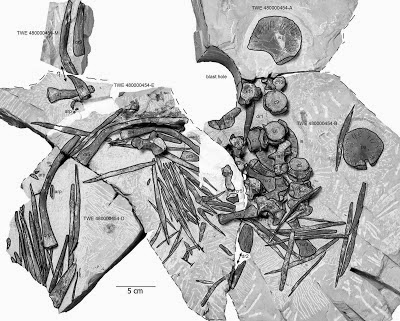Psephoderma alpinum is an armoured Placodont (a group of Marine Reptiles known only from the Triassic and thought to be related to Plesiosaurs) known from a number of locations
in the Alps. It has a long rostrum (snout) which may have been used to probe
soft sediments in a similar way to modern Batoid Rays, and large, flattened
teeth which were probably used to crush Clams and other hard prey.
In a paper published in the Swiss Journal of Geoscience on 20
November 2014, James Neenan and Torsten Scheyer of the Palaeontological Institute and Museum at the University of Zurich, describe a new specimen of Psephoderma alpinum from an exposure of
the Kössen Formation on Mount Schesaplana, the highest peak in the Rätikon
Range, which straddle the border between
Switzerland and Austria.
The skull of Psephoderma alpinum. Photographs
of the specimen in dorsal (a) and palatal (b) views. Virtual reconstructions
based on lCT data in dorsal (c) and palatal (d) views. Scale bar 20 mm.
Neenan & Scheyer (2014).
The new specimen is a nearly intact skull 146.5 mm in length, but
slightly crushed dorsolaterally (flattened from above). This specimen reveals a
number of features of the skull that have now previously been observed,
including the structure of the braincase, which was revealed by CT scanning the
specimen at the Steinmann Institute at the University of Bonn.
The specimen lacks the extensive nerve network in the snout seen in
other animals that use their snouts to sift through sediment, including the
closely related Chinese Placodont, Psephochelys polyosteoderma,
which casts doubt upon this interpretation of the biology of Psephoderma alpinum. It also shows poor
preservation of the occipital region (at the back of the skull), which has
previously been reported in other specimens. Neenan and Scheyer suggest that
this may indicate that these specimens were juveniles with incompletely mineralized
skeletons, or alternatively that Psephochelys
polyosteoderma may have been less reliant on hard (durophagus) prey than
other Placodonts, and therefore needed less heavy mineralization on parts of
the skull; this fits well with the sediment sifting interpretation of the
feeding habits of the animal, differing from the evidence from the nerves of
the snout, so it is likely that at least one of these pieces of evidence is
taphonomic (preservational) rather than biological in origin.
See also…
Placodonts were a group of Sauropterygian Reptiles (a group related to
Snakes and Lizards that includes the better known Pliosaurs and
Plesiosaurs which survived to the end of the Mesozoic) from the mid-to
late Triassic. They were large animals, ranging one to...
Follow Sciency Thoughts on Facebook.


